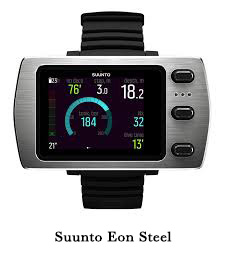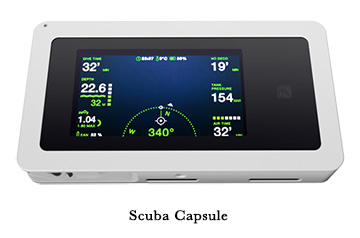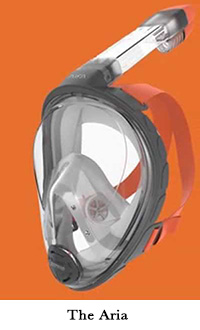Anything New at the DEMA Show?Contents of this Issue: XTC Dive Center, Xcalak, Mexico New Rules for Lithium-Ion Batteries on Airplanes Security Concerns for Diving in Malaysia Cuan Law, British Virgin Islands Hammerhead on the California Coast: “It Kept Coming At Me” Anything New at the DEMA Show? Getting Batteries for Old But Reliable Dive Computers Do Sport Divers Need a Spare Air? Carl Roessler, Steve Jobs and the “Maddened Attack” Editorial Office: Ben Davison Publisher and Editor Undercurrent 3020 Bridgeway, Suite 102 Sausalito, CA 94965 photography and technical diving dominate from the November, 2015 issue of Undercurrent
Despite its name, the annual DEMA trade show, produced by the Diving Equipment & Marketing Association and held two weeks ago in Orlando, FL, has almost turned into a dive travel show, with booths from every possible destination vying for business. While a press release from the Indonesian tourist office describes the remote Raja Ampat as "well-known," it seems like only yesterday that I made my way to West Papua's Bird's Head peninsula and the only dive operation in the region. Now, the Indonesian government is limiting liveaboard licenses in Raja Ampat to 40. How times change.
DEMA provides a good sounding board for what equipment manufacturers are thinking, and this year, it looks as if they are marketing more products to existing customers rather than to those who might be tempted to take up diving for the first time. For example, a plethora of booths proudly exhibited improved and refined closed-circuit rebreathers, such as the Inspiration Evo, with its modernized handset and display (www.apdiving.com), and an apparent obsession with all aspects of technical diving. Most of them seemed to have given up on providing anything new for the ordinary single-tank leisure diver, because those who adventure into technical diving buy a lot more equipment. Why sell a single regulator to a leisure diver when you can sell four to a techie? A decade ago, a Mares executive swore to me that his company would never entertain the techie business segment because it represented such a small percentage of its potential market, but now it has proudly launched the comprehensive XR extended range product line with the headline, "Farther. Deeper. Beyond." (https://www.facebook.com/MARESjustaddwater/videos/1063688340322550) Dive shop buyers seemed to be lapping it all up, and the shelves of those dive stores still in business next year will almost certainly be full of techie gear. I say "still in business" because dive stores worldwide are in crisis and are closing down at an alarming rate. Could it be that this obsession with deep diving is excluding those who would otherwise take up scuba diving? It's a question worth considering. Among the techie products in this Mares range, which includes all manner of metal back-plates, harnesses and wings, is the R2S-VR regulator, which unusually routes its hose vertically downward from the second stage. This in turn puts that hose conveniently under the arm of the user instead of over his shoulder. Although it's primarily designed for side-mounted or multiple-tank users, I can see its tidy design being adopted by single-tank divers, too. The conveniently angled high-pressure ports put these hoses neatly to one side also. (www.mares.com) Mostly Cosmetic Improvements Meanwhile Cressi, a neighbor of Mares in Italy, displayed a sleek and lightweight BCD with integrated weight pockets called the Ultra Light. I wrote a rave review of a similar BCD, the SeaQuest 3D, 20 years ago, but it was soon discontinued because in those days, nobody wanted to buy such a thing. Severe airline charges for overweight baggage have changed the way people think today. (www.cressi.com) Scubapro, Oceanic Worldwide, Aqua Lung, as well as the brands that are now part of the Huish Outdoors empire (Suunto, Atomic, Bare, Zeagle), exhibited cosmetically improved products, not too dissimilar to last year's. Oceanic continues to promote its Explorer semi-closed-circuit rebreather to the leisure diver who wants to look like a Stormtrooper from Star Wars, but it otherwise confers little advantage over a simpler, more easily transported and less expensive open-circuit system. Suunto has responded to the recent research asserting that deep stops might do more harm than good by allowing one to abandon that setting on its top-of-the-line computer, the Eon Steel, when used with nitrox. Suunto also revealed its updated range of computers, suffixed "Novo," which will soon replace the aging but successful Vyper and its siblings. (www.suunto.com) The Omnix computer from Liquivision claimed to have a new platform design, and it has a much better "manufactured" appearance than that company's previous worthy but boxy-looking products. With a brightly colored display, the Omnix features "transflective technology" that increases its legibility in bright ambient light. Not only can it be wirelessly integrated among up to 10 other divers (an advantage for instructors escorting trainees on their first ocean dives), techies can also switch it between three different nitrox mixes during the same dive. (www.liquivision.com) If I may digress, over the years, we have seen various systems for alerting other divers to the airstatus of individuals, but these have never proved popular. It seems that a diver running low on air prefers to keep this vital information private until the last moment -- who knows why? Dive System, another Italian manufacturer, introduced an advanced computer, the Ratio iX3M. It not only monitors several divers, it has an LED display on the tank-mounted air-integration transmitter that tells everyone networked what's left in a tank. This also comes with a heads-up display for the user, and is available as a stand-alone product. I wonder how many people are brash enough to buy into that idea? The all-singing, all-dancing Ratio iX3M also claims to be the first diving computer with integrated GPS navigation, although it was not clear how that would function underwater. Like many current computers, it gives the knowledgeable user a choice of algorithms to use. (www.divesystem.com) Some Useful Dive Accessories
The more complex Diveroid works with the latest Samsung Galaxies to provide dive computer, camera, compass and automatic logbook functions to recreational no-deco diving depths. When used as a camera underwater, the Galaxy retains essential diving information on the display. But don't expect to make phone calls underwater with either the iPhone or Galaxy. (www.diveroid.com) The Buddy Watcher, which you wear on your arm, allows fast and soundless communication between buddies, guides and instructors up to 66 feet apart, using a vibrator and a set of LEDs. It provides a more discreet method of contact than those annoying rattles or banging on your tank. (www.buddy-watcher.com) If you want to carry out a conversation underwater and spend less than $50 in doing so, Voice-inthe- Sea showed a selection of solutions that were as simple as two cans and a length of string might be. The basic Toucan model is a soft plastic tube around a couple of feet long, with diaphragms at each end. One diver holds one end to his ear, while the other speaks normally into the mouthpiece at the other end, once purged of water, sort of an underwater ear trumpet. Will this be a one-DEMA-showonly product and sink without a trace? (www.voiceinthesea.com) There were numerous remotely-operated vehicles, both free-ranging and sea floor-traveling, but the Swedish TTR-SB SeaWolf particularly caught my eye. It carries a GoPro camera and is operated by a diver using a controlling leash, rather like walking the dog. One can control it in shallow water from the surface with an iPhone or from the shore by radio control. (http://ttrobotix.com/product/seawolf) Sharks continue to be the subject of a love-hate relationship with people. Isn't it ironic that companies advocating shark deterrents like NoShark (http://bluvand.com) and Shark Shield (https://sharkshield. com) were in the convention center booths cheek by jowl with those of dive operators advocating in-your-face shark diving experiences and conservation groups advocating shark protection? The Busiest Part of the DEMA Show Floor The underwater photography section of the DEMA show was as busy as ever, with the American company Ikelite (www.ikelite.com) and the Austrian manufacturer Subal (http://subal.com) both rising to the recent challenges mounted by Nauticam in Hong Kong with new and vastly improved DSLR camera housings. The Japanese manufacturer Acquapazza brightened the trade show floor with a dazzling array of 15 different colored metal housings for the popular Sony RX 100 Mk4 compact camera, with an optional LCD screen hood for bright conditions. They can work with either M67 or LD (bayonet-fitting) wet lenses. Similarly using Inon dome ports and wet lenses, the APSG-dpQ housing accommodates the Sigmas Quattro range of cameras. Divers suffering pixel envy may be satisfied with the APSO-A72 Acquapazza housing, which is made for the 42.4 megapixel Sony A7 fullframe mirrorless camera. It can be used at an astounding light sensitivity level approaching ISO 41,000. (www.acquapazza.jp/en) Someone ruefully asked me how many light mounting solutions could a niche market as underwater photography bear, with so many companies offering their versions of the one-inch ball-and-clamp system? While Fisheye showed some clever electronics with its FIX range of lamps (evidently we don't judge light by Kelvin any more; it's now by the color-rendering index, or Ra), Orcalight demonstrated a 30,000 lumen monster that was only rivalled by Keldan's Swiss-made modular video lights with up to 26,000 lumens output (www.orcalight.co.uk; http://keldanlights.com). At the other end of the price range, iTorch offered a range of lamps that complimented its equally impressive range of options for housing iPhone cameras (complete with wide-angle lens options) and even for taking a GoPro to 500 feet deep. (http://itorch.ca)
GoPro cameras and the other mini POV clones have come to dominate underwater videography as much as they have every other sporting activity, and various accessories for them were revealed, including a 360-degree system by 360Heroes (www.360heros.com). Backscatter demonstrated its improved and refined Flip4 flip-filter system for the GoPro, to be priced lower than its popular Flip 3.1. (www.flipfilters.com) The Most Significant New Product on Display? Strangely enough, it was not intended for scuba divers, but merely for those who want to lie on the surface looking down at the underwater world -- a full-face snorkelling mask. Several manufacturers offered it, and all but one appeared to be exhibiting the same product, the Aria, made by Ocean Reef (www.oceanreefgroup.com). Allowing one to breathe naturally through the nose, it is designed to eliminate jaw discomfort and mask fogging, as well as water in the snorkel, by circling the air down through a top tube, around the face and back out through an exhaust. Users can even talk while using it, though it cannot be used for breath-hold diving. The H2O Ninja Mask, an almost identical product, is similarly made from polycarbonate and silicone and has the almost obligatory docking point for a GoPro POV camera. Its Hawaiian manufacturer claims to have already sold 5,000 units. Available in a wide range of pastel colors, it will be a great treat for nondivers and especially kids. (www.h2oninjamask.com) John Bantin is the former technical editor of DIVER magazine in the United Kingdom. For 20 years, he used and reviewed virtually every piece of dive equipment available in the U.K. and the U.S., and made around 300 dives per year for that purpose. He is also a professional underwater photographer, and most recently the author of Shark Bytes, available at www.undercurrent.org |

I want to get all the stories! Tell me how I can become an Undercurrent Online Member and get online access to all the articles of Undercurrent as well as thousands of first hand reports on dive operations world-wide
| Home | Online Members Area | My Account |
Login
|
Join
|
| Travel Index |
Dive Resort & Liveaboard Reviews
|
Featured Reports
|
Recent
Issues
|
Back Issues
|
|
Dive Gear
Index
|
Health/Safety Index
|
Environment & Misc.
Index
|
Seasonal Planner
|
Blogs
|
Free Articles
|
Book Picks
|
News
|
|
Special Offers
|
RSS
|
FAQ
|
About Us
|
Contact Us
|
Links
|
3020 Bridgeway, Ste 102, Sausalito, Ca 94965
All rights reserved.

 Is the Sport Diver Taking a Back Seat to Tech Diving?
Is the Sport Diver Taking a Back Seat to Tech Diving? So what products were relevant to the typical traveling diver? The Scuba Capsule encloses an
iPhone and turns it into a useful diving instrument that evidently can be taken down to 660 feet. A
downloadable app allows the iPhone to act as a dive computer with a choice of algorithms, comprehensive
dive planner and automatic data storage. One must wonder whether the iPhone will eventually
drive computer manufacturers out of business. (
So what products were relevant to the typical traveling diver? The Scuba Capsule encloses an
iPhone and turns it into a useful diving instrument that evidently can be taken down to 660 feet. A
downloadable app allows the iPhone to act as a dive computer with a choice of algorithms, comprehensive
dive planner and automatic data storage. One must wonder whether the iPhone will eventually
drive computer manufacturers out of business. ( Most impressive, but still in development, by i Torch were the Simbiosis SS-1 and SS-2 underwater
photographer's strobes that work in conjunction with -- and were powered by the battery by -- one of
the same manufacturer's LED video lights. It might provide an important alternative to those products
from Sea & Sea and Inon that monopolize the market. At the same time, iTorch exhibited the prototype
of a mini lighting system with two heads mounted on flexible arms, intended for use with a mini pointof-
view (POV) camera.
Most impressive, but still in development, by i Torch were the Simbiosis SS-1 and SS-2 underwater
photographer's strobes that work in conjunction with -- and were powered by the battery by -- one of
the same manufacturer's LED video lights. It might provide an important alternative to those products
from Sea & Sea and Inon that monopolize the market. At the same time, iTorch exhibited the prototype
of a mini lighting system with two heads mounted on flexible arms, intended for use with a mini pointof-
view (POV) camera.